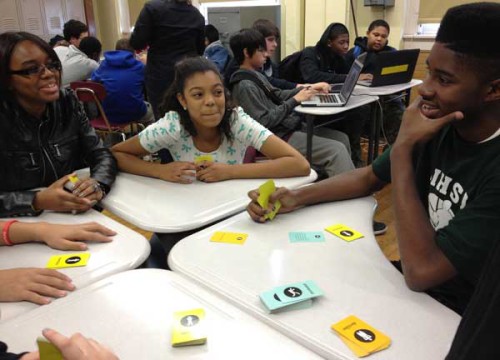10 PRINT in 64 bytes of JavaScript
From p01 comes a 64 byte JavaScript program to produce a random-seeming maze, as long as the person at the computer is willing to wiggle the mouse a bit. It’s on pouet.net, with comments, too.
From p01 comes a 64 byte JavaScript program to produce a random-seeming maze, as long as the person at the computer is willing to wiggle the mouse a bit. It’s on pouet.net, with comments, too.
Earlier this month the Tiltfactor team headed down to New York to play new game prototypes and our classic hits with high school students on Staten Island. Professor Flanagan gave students insight into the process of designing games, and then they got a chance to try them out! As you can see below, the testers loved Awkward Moment (as always).

The students also enjoyed Microbes, a fast and furious card game designed to encourage players to wash their hands. They shared their thoughts about the game, which will help our design team improve the game play experience and our researchers make the game as effective as possible!
My novel World Clock, generated by 165 lines of Python code that I wrote in a few hours on November 27, 2013, is now available in print.
World Clock tells of 1440 incidents that take place around the world at each minute of a day. The novel was inspired by Stanislaw Lem’s “One Human Minute” and Harry Mathews’s “The Chronogram for 1998.” It celebrates the industrial concept of time and certain types of vigorous banality which are shared by all people throughout the world.
The new project European Poetry Forum by Zuzana Husarova Martin Solotruk is now online.
The project aims to connect a diverse group of poets with overlapping interests, as this statement about it explains. There are answers to queries from 38 poets up now.
Just posted: TROPE-13-03 – No Code: Null Programs by Nick Montfort, in the Trope Report series (technical reports from my lab the Trope Tank at MIT).
To continue the productive discussion of uninscribed artworks in Craig Dworkin’s No Medium, this report discusses, in detail, those computer programs that have no code, and are thus empty or null. Several specific examples that have been offered in different contexts (the demoscene, obfuscated coding, a programming challenge, etc.) are analyzed. The concept of a null program is discussed with reference to null strings and files. This limit case of computing shows that both technical and cultural means of analysis are important to a complete understanding of programs – even in the unusual case that they lack code.
Online magazine The Claudius App, devoted to “fast poems and negative reviews,” is now in its fifth number and clad in the classic Sim-City-like skin of a burning New York City. There’s a more standard but still DOS-like directory listing, with links to much fine fare, including a translation of a Georges Perec piece and an interactive but also self-scrolling work, “Titanichat,” by Cecilia Corrigan and Ian Hatcher. It comes with a soundtrack, too.
Collect all five numbers, with their curiously strong interfaces: 1,
2,
3,
4,
5.

A great tribute. I’m sure this company wants you to feel Mandela-like while you line their coffers and lock yourself into consumption. This company would of course have you forget that the Nelson Mandela of computing would actually smash a corporate oppressor. Apple, Inc. metaphorically incarcerates mobile phone users, which is why they need to jailbreak their phones. And free speech doesn’t exist in the Apple Store, as it still does on the Internet. Apple, Inc. chooses what you are allowed to say and what computation you are allowed to do, so if you want privacy, no – on the other hand, if you want to be cured of homosexuality, you got it. Not that I object to different and even hateful opinions in a realm where free speech is allowed – but there is no such realm in this iCorporate la-la land.
Slavoj Žižek did not write a twine game, but Alan DeNiro did. It’s called We Are the Firewall, and it has more rodents than Rat Chaos. It twists and communicates with the whole category of Twine games quite well, and the writing is quite compelling, and it’s well worth reading/solving.
DeNiro, by the way, is the author of (in addition to short stories and novels) the uncanny interactive fiction Deadline Enchanter, which I also recommend.
The next Electronic Literature Organization conference, to take place in Milwaukee on June 19-21, has just extended its deadline for submission to December 15. Media Art Show proposals and abstracts for academic talks are both welcome.
A single-loading VIC-20 demo (3583 bytes) presented on November 30, 2013 at Récursion in Montréal. By Nick Montfort, Michael C. Martin, and Patsy Baudoin (nom de nom, mcmartin, baud 1). This video is of the demo running in the Trope Tank at MIT on December 3, 2013.
Tagged on YouTube as Commodore VIC-20, Samuel Beckett, Electronic Literature, Computer (Musical Instrument), and Demoscene. See also the fuller story about Nanowatt with links to executable code.
There are some things I absolutely must mention at this point, to highlight certain of the many interesting outcomes from NaNoGenMo (National Novel Generation Month):
Alice’s Adventures in the Whale, one of two novels created by Leonard Richardson by computationally replacing all the dialog in one novel with the dialog in another:
Alice was beginning to get very tired of sitting by her sister on the bank, and of having nothing to do: once or twice she had peeped into the book her sister was reading, but it had no pictures or conversations in it, “Can’t sell his head?–What sort of a bamboozingly story is this you are telling me?” thought Alice “Do you pretend to say, landlord, that this harpooneer is actually engaged this blessed Saturday night, or rather Sunday morning, in peddling his head around this town?”
Powered by WordPress